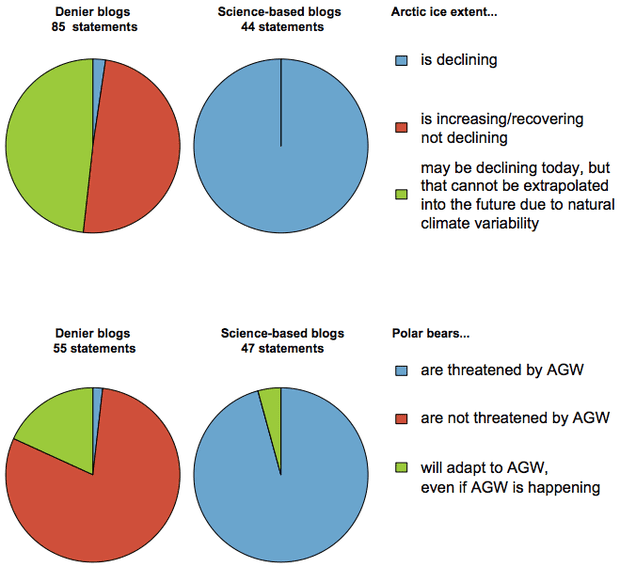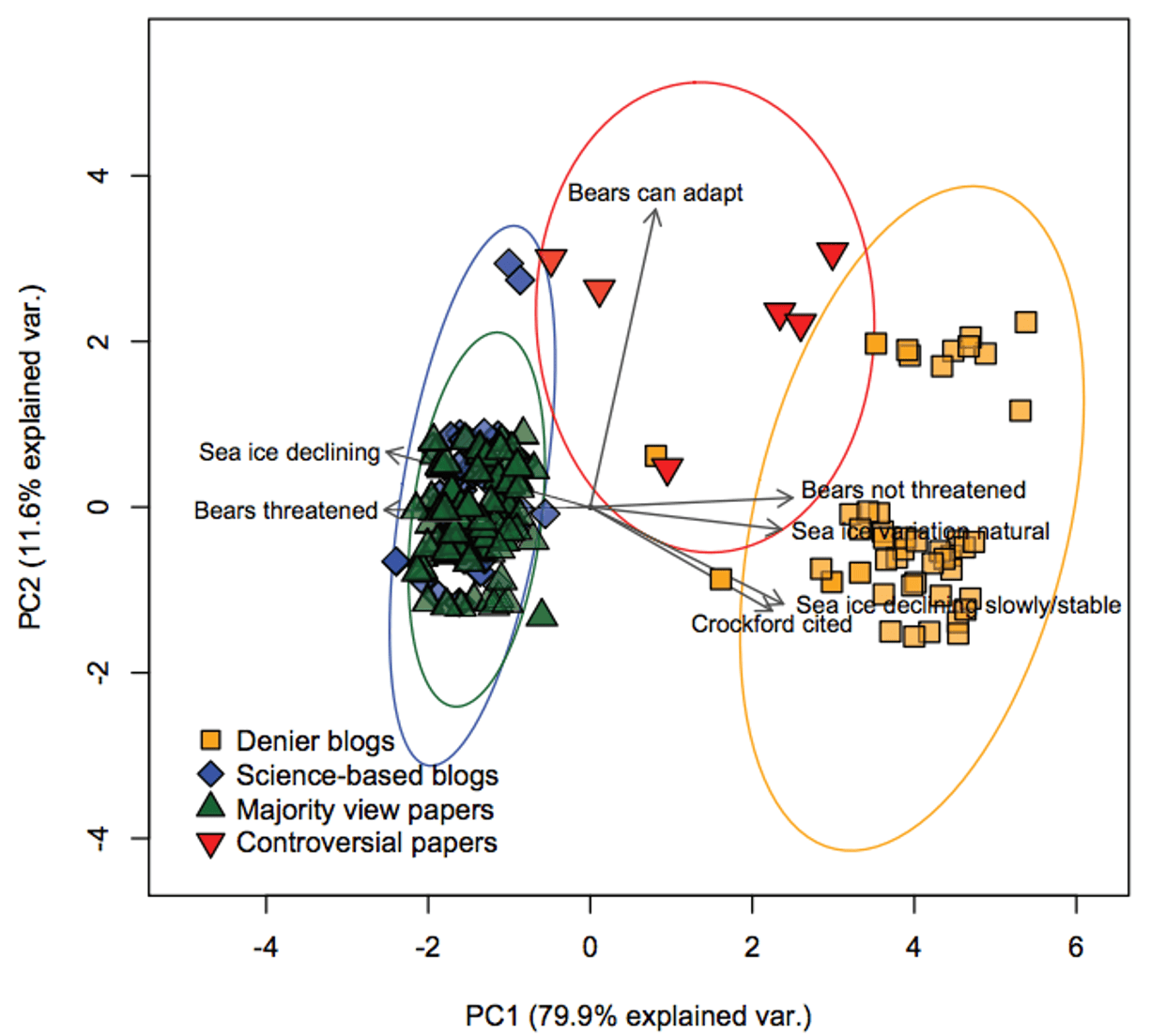
The body of evidence supporting human-caused global warming is vast – too vast for climate denial blogs to attack it all. Instead they focus on what a new studypublished in the journal Bioscience calls “keystone dominoes.” These are individual pieces of evidence that capture peoples’ attention, like polar bears. The authors write:
These topics are used as “proxies” for AGW [human-caused global warming] in general; in other words, they represent keystone dominoes that are strategically placed in front of many hundreds of others, each representing a separate line of evidence for AGW. By appearing to knock over the keystone domino, audiences targeted by the communication may assume all other dominoes are toppled in a form of “dismissal by association.”
Basically, if these bloggers can create the perception that the science underlying polar bear or Arctic sea ice vulnerability to climate change is incorrect, their readers will assume that all of climate science is fatally flawed. And blogs can be relatively influential – surveys have shown that blog readers trust them more than traditional news and information sources.
In this study, the authors examined the arguments made by 45 denier blogs and 45 science-based blogs regarding the impact of human-caused global warming on polar bear populations and Arctic sea ice extent. They found that the science-based blogs all showed that Artic sea ice is declining, and nearly all said that global warming threatens polar bear populations.
Conversely, the denier blogs nearly all denied that Arctic sea ice is declining or argued that we can’t predict how it will change in the future, and that polar bears aren’t threatened and/or will adapt to climate change.

Pie charts showing the percentage of 45 science-based and 45 denier blogs expressing positions on the effects of human-caused global warming (AGW) on Arctic ice extent and polar bears. Illustration: Harvey et al. (2017), Bioscience
The authors also noted that unsurprisingly, the science-based blogs had much stronger supporting arguments:
Scientific blogs provided convincing evidence that AGW poses a threat to both, whereas most denier blogs did not. Science-based blogs overwhelmingly used the frame of established scientific certainties and supported arguments with the published literature affirming that warming is rapidly reducing seasonal Arctic sea-ice extent and threatening the mid- to longer-term survival of polar bears, whereas those written by deniers did not.
In fact, on the question of polar bears, the study authors found that as their primary source, nearly 80% of denier blogs referenced another blog written by a zoologist named Susan Crockford. However, Crockford has never conducted research on current polar bear populations or published any peer-reviewed studies on the subject. There are experts on this subject, like the Polar Bear Specialist Group, but deniers cite Crockford quite simply because she’s one of the few scientists who tells them what they want to hear.
The study authors also examined 92 peer-reviewed papers on polar bears and Arctic sea ice and grouped them using the same categories as the denier and science-based blog posts. As the figure below shows, the scientific research (green triangles) is extremely consistent in concluding that climate change threatens both polar bears and Arctic sea ice, although a few papers (6.5% - the red triangles) suggested that polar bears might be able to adapt to their changing environment.
The science-based blogs (blue diamonds) cluster quite closely to the findings in the scientific research, while the denier blogs (yellow squares) are off in their own world denying that human activity is causing a long-term decline in polar bear populations and Arctic sea ice.

Categorization using principle component (PC) analysis of statements regarding polar bears and Arctic sea ice from 90 blogs and 92 peer-reviewed studies. Illustration: Harvey et al. (2017), Bioscience
Indeed, the scientific research is quite clear that Arctic sea ice is in the midst of a rapid decline due primarily to human-caused global warming. Because polar bears rely on sea ice to hunt seals, global warming also threatens their species. While some polar bear sub-populations are stable thus far, others are declining, and that trend will only accelerate as sea ice continues to disappear.
The authors conclude their paper by encouraging their scientific colleagues to engage with the public and counter scientific misinformation:
We believe that it is imperative for more scientists to venture beyond the confines of their labs and lecture halls to directly engage with the public and policymakers, as well as more strongly confronting and resisting the well-funded and organized network of AGW denial. This can be done in numerous ways. For example, scientists can be more proactive in approaching the media to emphasize the importance of research findings or to counter misinterpretations. They can also begin to encourage initiatives that empower citizen participation in scientific research, such as citizen science, as is being done currently at several major universities and research institutes. Moreover, scientists need to more effectively use Internet-based social media to their full advantage in order to turn the tide in the battle for public opinion.
They note that this is no simple request because there are few rewards in academics for those who combat misinformation. In fact, many like Katharine Hayhoe, Michael Mann, a Ben Santer have been attacked for their scientific work through what study co-author Mann coined ‘the Serengeti Strategy’:
Nevertheless, climate denial can be influential, and climate scientists remain trusted sources.
Posted by dana1981 on Wednesday, 29 November, 2017
 |
The Skeptical Science website by Skeptical Science is licensed under a Creative Commons Attribution 3.0 Unported License. |